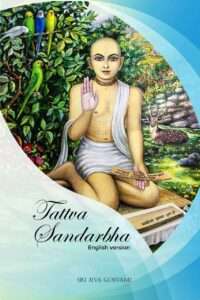 Analysis of the writings
Analysis of the writings
Preserving tradition through a prolific literary production became his most important service. Even today, scholars are amazed by such and so much work. It is difficult to make a list of his writings. Jiva Gosvami has composed and edited the publication of at least twenty-five texts, all important classics of the Gaudiya line.
Let’s say something about one of the most important: his work dedicated to grammar, entitled Hari-namamrta-vyakarana. Janardana Cakravarti referred to the text saying:
“It is a very ingenious treatise that uses the names of God to enunciate the rules of Sanskrit grammar.”
The attempt to explain grammar using the innumerable appellations of Krishna had an illustrious precedent: Lord Caitanya himself got the idea while teaching vyakarana to his students in Navadvipa. Therefore, Jiva Gosvami did nothing but follow in the footsteps of the master.
Among the most intensely theological works, we find the Gopala Campu, a great epic written in a complex poetic style, describing the innumerable activities of Krishna in His original manifestation. It is divided into two parts: the first part (purva) consists of 33 chapters and describes in detail the activities of Krishna in Vrindavana. The second part (uttara), consisting of 37 chapters, deals with Krishna’s activities in Mathura and Dvaraka.
Equally dense in significance is the famous Krama Sandarbha. Often described as “the seventh” of the six Sandarbhas, it is a decidedly elaborate commentary on the twelve cantos of Srimad-Bhagavatam.
Perhaps even more important are the same Sat (six) Sandarbhas. Srila Prabhupada gives us a summary of its contents:
“Bhagavat-sandarbha is also known as Sat-sandarbha. In the first part (Tattva-sandarbha), it is shown that Srimad-Bhagavatam is the most authoritative evidence that tends to directly show the Absolute Truth.”
“The second Sandarbha (Bhagavat-sandarbha) makes a distinction between impersonal Brahman and localized Paramatma.”
“The third Sandarbha (Paramatma-sandarbha) explains that Paramatma exists within millions and millions of living entities; it is also specified that the incarnations of the lila-avatara answer the desires of the devotees and that the Supreme Personality of Godhead is characterized by the six opulences.”
“The fourth Sandarbha (Krishna-sandarbha) proves that Krsna is the Supreme Personality of Godhead.”
“The fifth Sandarbha (Bhakti-sandarbha) explains how to perform devotional service directly.”
“The sixth Sandarbha (Priti-sandarbha) is a dissertation on love for God.”
The six Sandarbhas are said to represent the perfection of sambandha-jnana, abhideya-jnana and prayojana-jnana. The first four Sandarbhas are dedicated to sambandha, the fifth treats of abhideya and the sixth of prayojana.
The Brahma-sanghita-tika (or Dik-darsani) is a commentary on the Brahma-sanghita. The Bhakti-rasamrta-sesa is a commentary on Bhakti-rasamrta-sindhu. The Locana-rocani is a commentary on the Ujjvala-nilamani. The Yogasara-sta-tika is a commentary on the Padma Purana. The Gayatri-bhasya is an explanation of the Gayatri-mantra: it records the teachings contained in this regard in the Agni Purana.
This is a section of the book “Tattva Sandarbha”, in English.
To buy the complete book, click here



Leave a Reply